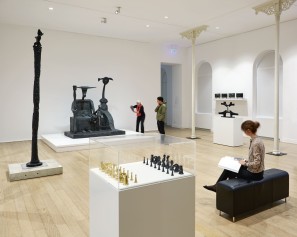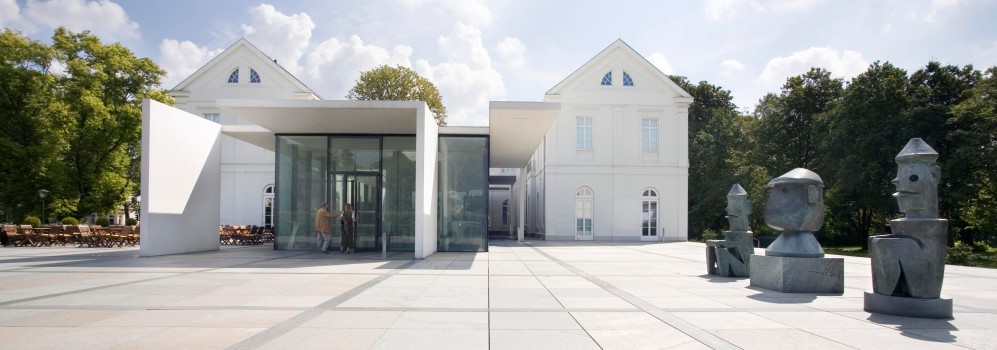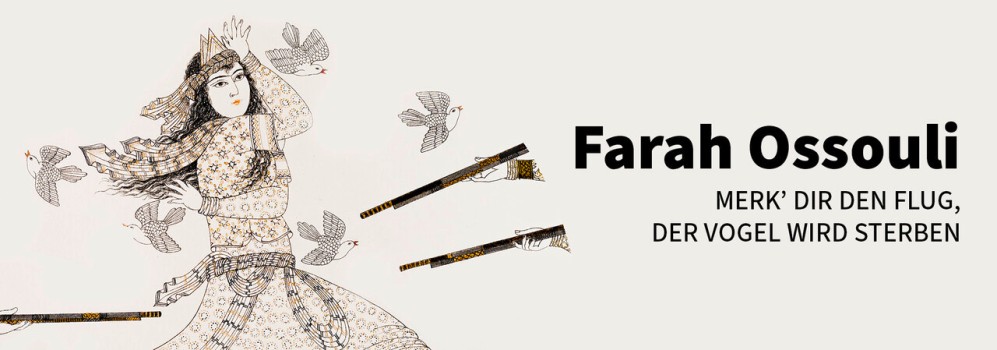
© VG Bild-Kunst, Bonn 2023
Max Ernst: Life and Work
Around 250 artworks by Max Ernst from over 70 years of his artistic career – including paintings, sculptures, objects, photographs and works on paper – are on display in the permanent exhibition ‘Max Ernst - Life and Work’ on the ground and upper floors of the museum. Important photographs from the artist's archive are shown alongside the artworks to document his multifaceted life and his artist friendships.
Surreal visual worlds, fantastical sculptures and D-paintings
The permanent exhibition has a chronological structure and presents Max Ernst's artistic beginnings in Brühl and the Rhineland, the 1920s and 1930s in Paris until his emigration to the USA and his return to Europe in the 1950s until his death in 1976.
Max Ernst initially explored the popular art movements of his time, Impressionism, Expressionism and Fauvism. As a reaction to the First World War, he was a founding member of the Dada movement in Cologne and created his first collages and Dadaist drawings, shown in the permanent exhibition.
In the 1920s, Max Ernst left for Paris and joined the Surrealist group. There he created numerous paintings, collages, graphics, sculptures and assemblages until his escape to America in 1941. His unbridled creativity is also reflected in numerous books, artist's portfolios and poems. In his visual worlds you will encounter fantastical landscapes and bizarre creatures. With Histoire Naturelle, the exhibition presents Max Ernst's newly invented technique, the grattage. From 1929, he also developed three collage novels. In the last of these novels, Une Semaine de Bonté (1934), he addresses the human abyss. The precisely assembled collages show scenes of destruction and social drama, sexuality, torture and murder, as well as the forces of nature and the effects of the elements.
After several internments in France, Max Ernst emigrated to the USA. There he first settled in New York before moving to Sedona in the Arizona desert with Dorothea Tanning in 1946. Numerous works from his time in America bear witness to his continued exploration of surrealism and landscape in the USA. His large sculpture and main work from the Sedona period, Capricorne, is on display in the Tanzsaal of the Max Ernst Museum.
Over 70 bronze sculptures and sculptures from Max Ernst's personal collection demonstrate his sculptural work over the decades. The centrepiece of the permanent exhibition are the 36 ‘D-Paintings’ on the upper floor of the museum. Max Ernst created these as birthday and romantic gifts for his last wife, the artist Dorothea Tanning.
An eventful life in Europe and the USA
Are you curious about individual works of art and the background to their creation? Discover even more about Max Ernst on the accompanying
Mediaguide Max Ernst - Life and Work
This also contains an audio guide in German, English and easy language. In the exhibition, you can find the audio guide via QR codes on selected works of art.







